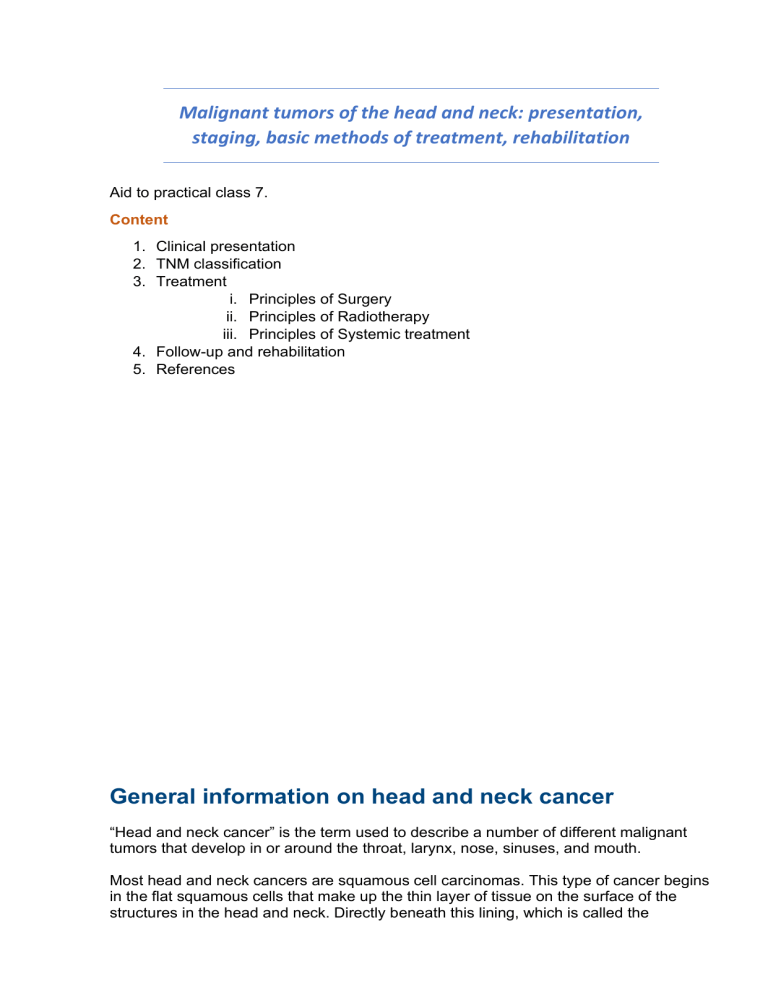
Malignant tumors of the head and neck: presentation, staging, basic methods of treatment, rehabilitation Aid to practical class 7. Content 1. Clinical presentation 2. TNM classification 3. Treatment i. Principles of Surgery ii. Principles of Radiotherapy iii. Principles of Systemic treatment 4. Follow-up and rehabilitation 5. References General information on head and neck cancer “Head and neck cancer” is the term used to describe a number of different malignant tumors that develop in or around the throat, larynx, nose, sinuses, and mouth. Most head and neck cancers are squamous cell carcinomas. This type of cancer begins in the flat squamous cells that make up the thin layer of tissue on the surface of the structures in the head and neck. Directly beneath this lining, which is called the epithelium, some areas of the head and neck have a layer of moist tissue, called the mucosa. If a cancer is only found in the squamous layer of cells, it is called carcinoma in situ. If the cancer has grown beyond this cell layer and moved into the deeper tissue, then it is called invasive squamous cell carcinoma. If doctors cannot identify where the cancer began, it is called a cancer of unknown primary. If a head and neck cancer starts in the salivary glands, the tumor will usually be classified as an adenocarcinoma, adenoid cystic carcinoma, or mucoepidermoid carcinoma. Overall, H&N cancer include following sites: • Cancer of the Lip • Cancer of the Oral Cavity • Cancer of the Oropharynx • Cancer of the Hypopharynx • Cancer of the Nasopharynx • Cancer of the Glottic Larynx • Cancer of the Supraglottic Larynx • Ethmoid Sinus Tumors • Maxillary Sinus Tumors Clinical presentation Diagnosis The need for expeditious diagnosis of head and neck cancer and referral to skilled head and neck specialists cannot be overemphasized, as early diagnosis can lead to a reduction in mortality. One study suggested that in the 24 months prior to the diagnosis of head and neck cancer, patients had a median of 10.5 healthcare visits. These visits could have provided an opportunity to evaluate patients’ symptoms and underscore the important role of dentists and primary care physicians in the early diagnosis of head and neck cancer. History Risk factors, including a history of tobacco and alcohol use and environmental exposures, should be reviewed. Any adult patient with symptoms referable to the upper aerodigestive tract that have lasted longer than 2 weeks or with an asymptomatic neck mass should undergo a thorough examination with a high index of suspicion for carcinoma. Physical examination The physical examination is the best means of detecting lesions of the upper aerodigestive tract. Frequently, the initial assessment also will indicate the severity and chronicity of the disease. Due to the frequent occurrence of multiple primary tumors in patients with a head and neck tumor, careful evaluation of the entire upper aerodigestive tract is necessary at the time of diagnosis. The examination should always follow a systematic approach. Skin/scalp. A search should be made for ulcers, nodules, and pigmented or other suspicious lesions. This part of the evaluation is frequently overlooked. Cranial nerves. A cranial nerve evaluation is essential for any patient with a head and neck tumor or neck mass (which may be a manifestation of occult cancer). This evaluation should include assessing eye motion (cranial nerves [CN] III, IV, and VI); testing sensation of the face (CN V); examining the muscles of facial expression by having the patient grin, grimace, raise eyebrows, close eyes tightly, show teeth, and puff out the cheeks (CN VII); testing of hearing (CN VIII); assessing gag reflex (CN IX); evaluating vocal cord mobility (CN X); and having the patient fully abduct the shoulder (CN XI) and protrude the tongue (CN XII). Even the slightest abnormality may be helpful in identifying a primary tumor. Eyes/ears/nose. The eyes, ears, and nose should be evaluated for any sign of mass effect, abnormal drainage/discharge, bleeding, or effusion. Oral cavity. Halitosis may be the first indication of a lesion in the upper aerodigestive tract. The teeth, gingivae, and entire mucosal surface should be inspected. Fig. 1. Oral cancer on the side of the tongue, a common site along with the floor of the mouth (Dentures should be removed.) The lymphoid tissue of the tonsillar pillars should be inspected and any asymmetry noted. Tongue mobility also should be evaluated. Fig. 2. Asymptomatic T2N0M0 tonsillar cancer revealed on inspection of oral cavity. The floor of the mouth, tongue, and cheeks should be palpated using a bimanual technique (one gloved finger inside the mouth and the second hand under the mandible). Palpation should be the last step of the examination due to stimulation of the gag reflex. Worrisome lesions should be biopsied. Neck. A systematic examination of the neck consistently documents the location of any mass. Palpation is the cornerstone of the examination. It is performed by grasping the tissue and feeling the nodes between the thumb and long fingers. The relationship of a mass to major structures, such as the salivary gland, thyroid, and carotid sheath, should be considered. Fig. 3. An enlarged (4 × 4 cm), hard and fixed submandibular lymph node in a patient with a malignancy of bucco- lingual vestibule and alveolar ridge Important qualities of a mass include location, character, tenderness, size, mobility, and associated thrill or bruit. The thyroid should be palpated. Laryngoscopy. The nasopharynx, hypopharynx, and larynx should all be examined with care. The vocal cords should be inspected and their mobility evaluated. Mirror examination provides an overall impression of mobility and asymmetry, which may point to a hidden tumor. Fig. 4. Cancer of the left vocal fold on laryngoscopy. Nasopharyngoscopes permit a thorough inspection of the upper aerodigestive tract in the office setting. Attention should be focused individually on the piriform sinuses, tongue base, pharyngeal walls, epiglottis, arytenoids, and true and false vocal cords. Also, any pooling of secretions should be noted. Fig. 5. A. Nasopharyngoscopy revealed a whitish mass (yellow asterisk) in the nasopharynx. B. The nasopharyngeal mass was removed by endoscopic resection. (Black asterisk indicates the of nasal septum. Black arrows indicate the Eustachian tubes). TNM Classification Staging System The TNM staging system of the American Joint Committee on Cancer (AJCC) maintains uniformity in the staging of head and neck tumors. Prognosis correlates strongly with stage at diagnosis. For many head and neck cancer sites, survival of patients with stage I disease exceeds 80%. For patients with locally advanced disease at the time of diagnosis, (ie, stages III and IV disease), survival drops below 40%. Development of nodal metastases reduces survival of a patient with a small primary tumor by approximately 50%. Involvement of even a single lymph node is associated with a marked decline in survival. Most patients with head and neck cancer have stage III or IV disease at diagnosis. The TNM classification of specific sites among H&N tumors is overall similar with some specific features for specific locations. Moreover, the staging systems for metastases and stage groupings are nearly uniform for all mucosal sites. Here are presented classifications of oral cavity, nasopharyngeal, and oropharyngeal (p-16 positive) cancers, extracted from NCCN. Table 1. American Joint Committee on Cancer (AJCC) TNM Staging Classification for the Oral Cavity (including mucosa of lip) (8th ed., 2017) Table 2. American Joint Committee on Cancer (AJCC) TNM Staging System for the Larynx (8th ed., 2017) Table 3. American Joint Committee on Cancer (AJCC) TNM Staging System for HPV-Mediated (p16+) Oropharyngeal Cancer (8th ed., 2017) (Not including: P16-negative [p16-] cancers of the oropharynx) Treatment Treatment Approaches In general, early-stage (stage I or II) head and neck tumors may be treated using a single modality (surgery or radiotherapy), whereas advanced disease (stage III or IV) frequently benefits from multimodality therapy. The best therapeutic approach for the primary tumor depends on the anatomic site. Most neck disease can be treated equally well with surgery or radiation, thus the modality chosen to treat the neck is based on which modality is selected for the primary. When the primary tumor is treated with irradiation, the regional lymphatics “at-risk” are incorporated into the treatment fields. Neck dissections should remain standardized (ie, complete anatomic dissections, as opposed to “berry picking” or random biopsy) in these settings to avoid incomplete surgery. Preoperative Assessment Before surgical resection, preoperative assessment of the extent of disease is essential. Complete physical examination and appropriate radiologic evaluation are necessary. Direct laryngoscopy and esophagoscopy are frequently performed to determine tumor extent and rule out the presence of a second primary tumor. A chest x-ray or CT scan may be obtained to screen for distant metastases or a primary lung cancer. Surgical Principles Classic principles of surgical oncology apply to head and neck cancer. Complete resection is necessary. Securing sufficient margins may be challenging because of the many structures in this area. Reconstruction is complex after resection of head and neck tumors, as the surgery may have an impact on appearance, speech, and swallowing. Decisions regarding the extent of resection should be made by experienced surgeons. Complex head and neck cancer surgery, conducted by high-volume surgeons at high-volume institutions, is associated with better outcomes at lower costs. A) C) B) D) E) F) Fig. 6. A patient a T4N1M0 squamous cell carcinoma arising from the lower gingiva. A) A CT scan showed that the tumour had already invaded the body of the mandible. B) The extraoral facial skin was also invaded. C, D) Radical surgery was performed to remove a segment of the mandible with the whole three-layer of the cheek. This patient presented a Type C defect (both elements of soft tissue and bone missed in close oneblock pattern). E, F) A fibular flap with chimeric design was then developed with two skin paddles, one block of the soleus muscle and one segment of the fibula to reconstruct the intra-oral mucosa, intermediate soft tissue and facial skin, respectively. Neck surgery Metastases from squamous cell carcinoma of the upper aerodigestive tract have a predictable pattern. This fact has permitted modifications of the classic radical neck dissection described by Crile in the early 20th century. Knowledge of the patterns of cervical lymph node metastases has led to various neck dissections, including the modified radical neck dissection, extended radical neck dissection, and selective neck dissections, which include the supraomohyoid neck dissection, anterior compartment neck dissection, posterolateral neck dissection, and lateral neck dissection. The classic radical neck dissection removes all of the ipsilateral lymph nodes, the submandibular salivary gland, sternocleidomastoid, internal jugular vein, and spinal accessory nerve. This is associated with multiple functional and cosmetic deformities. This is often combined with resection of the primary malignancy, which is achieved by several different approaches. A newer way of resecting some oral cavity, oropharyngeal, and hypopharyngeal primaries is through a transoral robotic surgical approach (TORS), which is actively being investigated at multiple centers. Sacrifice of the spinal accessory nerve (cranial nerve XI) results in impaired shoulder movement and the potential development of a painful fixed shoulder from denervating the trapezius muscle. Removal of the sternocleidomastoid muscle results in a cosmetic deformity, including flattening of the neck on the side of surgery. In most people, the removal of this muscle results in no real functional deficit. Removal of the ipsilateral internal jugular vein is tolerated in most people, particularly with modern anesthetic techniques. In most patients, limiting intravenous hydration, both intraoperatively and postoperatively, is important to prevent a syndrome of inappropriate antidiuretic hormone secretion, which has been demonstrated to occur in patients undergoing surgery for head and neck malignancies. Collateral veins, contralaterally and retropharyngeally, prevent significant postoperative edema. Removal of both internal jugular veins results in significant venous edema and chronic lymphedema of the face and can be fatal in 10% of patients when performed simultaneously. When bilateral jugular vein removal is necessary, stage the procedures at least 1 week apart to permit formation of these collaterals. For these reasons, various modifications have supplanted most radical neck dissections. The modified neck dissection can preserve the internal jugular vein, the spinal accessory nerve, and the sternocleidomastoid muscle, provided that lymph nodes containing tumor are not violated. Comparisons of the classic radical neck dissection with modified neck dissection have demonstrated that they are equally effective in controlling metastatic squamous cell carcinoma in patients with no clinical evidence of metastatic disease or with early metastatic disease. However, the functional neck dissection, in which the lymph nodes are removed, preserving the internal jugular vein, spinal accessory nerve, and sternocleidomastoid, [2] is not as effective for multiple cervical metastases or for bulky neck metastases. The radical neck dissection also is indicated if signs of extranodal spread involving the skin, carotid sheath, or deeper soft tissues of the neck are present. Surgery Plus Radiation Therapy The combination of radical surgery and radiation therapy has been used for several decades to treat patients with advanced head and neck cancers. Postoperative vs preoperative radiation therapy Postoperative radiation therapy (60 to 70 Gy in 6 to 7 weeks) reduces the rate of locoregional recurrence from approximately 50% to 15% for tumors with pathologic features predictive of locoregional recurrence. The indications for postoperative radiation therapy are well established and include a deeply infiltrative primary tumor (T4); close or positive margins; an involved lymph node > 3 cm or multiple involved lymph nodes; extracapsular extension; an open lymph node biopsy not followed by an immediate neck dissection; perineural invasion; invasion of the lymphovascular space, cartilage, bone, or deep soft tissue; and surgeon unease (an experienced surgeon’s recommendation to deliver postoperative radiation should be credited by the radiation oncologist because the surgeon will often appreciate worrisome features not documented in a pathology report). The addition of postoperative radiation therapy reduces the risk of locoregional failure but does not decrease the risk of developing distant metastases. Postoperative radiation treatment needs to begin expeditiously after resection, due to the risk of local recurrence; the current standard of care is that radiation begins 4 to 8 weeks after an operation. Preoperative radiotherapy (45 to 50 Gy in 4 to 5 weeks) has been used for patients with advanced primary tumors, but rates of locoregional recurrence appear to be lower and complications fewer with postoperative radiation therapy. This observation was based on a study performed in the 1970s, which is unlikely to be repeated in the modern era. Preoperative radiotherapy with or without chemotherapy is indicated for marginally resectable tumors, such as those with fixed cervical lymph nodes. In this setting, preoperative irradiation often permits resection of an otherwise unresectable tumor. However, this approach is used rarely because of the improvements in outcome with chemoradiation and the poor functional outcomes of patients requiring trimodality therapy. Postoperative chemotherapy/radiation therapy Two randomized clinical trials were launched to determine whether the addition of chemotherapy to radiation therapy enhanced locoregional tumor control and survival in high-risk patients with head and neck cancer following definitive surgical resection. The results of these trials were published in 2004. In the RTOG 95-01/Intergroup trial, patients with high-risk features including two or more involved lymph nodes, extracapsular extension, or positive margins following definitive surgical resection were randomized to receive 6,000 to 6,600 cGy of postoperative irradiation with or without cisplatin (100 mg/m2 given on days 1, 22, and 43). With a median follow-up of 45.9 months, the estimated 2-year rate of local and regional tumor control was 82% in the combined-therapy group vs 72% in the radiotherapy group (P = .01). The disease-free (P = .04), but not overall (P = .19), survival was significantly longer in the combinedtreatment group, although the primary endpoint was locoregional control and was not powered to demonstrate a survival advantage. The incidence of acute adverse effects (grade 3 or greater) was higher in the combined-treatment group (77% vs 34%; P < .001). In the European Organisation for Research on the Treatment of Cancer (EORTC) 22931 trial, similar conclusions were reported. This study included patients with T3 or T4 disease, perineural invasion, and involvement of the lymphovascular space in addition to positive margins and extracapsular extension. The overall survival rate was significantly improved in the combined-therapy group compared with the radiotherapy group. After a mean of 60 months, the overall survival of 334 randomized patients was 53% in the combined-treatment group vs 40% in the radiation-alone group (P = .02). The discrepancy in effect on overall survival between the two studies was thought to be related to different entry criteria used in the RTOG and EORTC trials. In a comparative analysis of the two trials, the presence of extracapsular extension and/or microscopically involved surgical margins were the only risk factors for which the impact of chemoradiation therapy significantly improved survival. Phase III trials designed to evaluate the benefit of newer agents are only now beginning. Curative radiation therapy Radiation therapy with curative intent usually involves daily treatment for 6 to 7 weeks (total dose: 60 to 70 Gy). Although there is no tissue loss with radiation therapy, as there is with surgery, potential complications include dry mouth, tissue fibrosis, trismus, bone necrosis, hypothyroidism, and dysphasia. Some problems are common and sufficiently debilitating that they require significant care during treatment planning. Surgery often produces less morbidity in the oral cavity, whereas radiotherapy may produce less morbidity in the oropharyngeal, laryngeal, and nasopharyngeal regions. Fig. 7. External beam radiotherapy for head and neck cancers is supplemented with thermoplastic mask, allowing immobilization of irradiated area during all the sessions. This helps robust delivery of the beam. Radiation fractionation The RTOG 90-03 trial was conducted to determine the efficacy of various fractionation schemes in the treatment of locally advanced head and neck cancer in the prechemotherapy era. Four schedules were tested: (1) standard fractionation at 2 Gy/fraction/d, 5 d/wk, to 70 Gy/35 fractions/7 wk; (2) hyperfractionation at 1.2 Gy/fraction, twice daily, 5 d/wk to 81.6 Gy/68 fractions/7 wk; (3) accelerated fractionation with split at 1.6 Gy/fraction, twice daily, 5 d/wk to 67.2 Gy/42 fractions/6 wk, including a 2-week rest after 38.4 Gy; or (4) accelerated fractionation with a concomitant boost at 1.8 Gy/fraction/d, 5 d/wk, and 1.5 Gy/fraction/d to a boost field as a second daily treatment for the last 12 treatment days to 72 Gy/42 fractions/6 wk. A total of 1,113 patients were entered in the study, with a median follow-up of 23 months. Patients treated with both hyperfractionation and accelerated fractionation with a concomitant boost had significantly increased locoregional tumor control rates (the primary endpoint) on RTOG 90-03 compared with patients on the other two arms. All three groups treated with the altered fractionation schemes had more acute, but not late, side effects. The study concluded that hyperfractionation and accelerated fractionation with a concomitant boost were both superior to conventionally fractionated radiotherapy. An update of this trial further demonstrated that the hyperfractionated arm showed a trend toward an overall survival benefit (P = .06); the accelerated fractionation arm using the concomitant boost showed a trend toward increased late side effects (P = .06). Around the same time, the benefit of concurrent chemotherapy was appreciated, and an early investigation by Brizel et al demonstrated that concurrent chemotherapy significantly improved locoregional control when added to hyperfractionated radiation. However, a subsequent larger randomized phase III trial reported by Nguyen-Tan et al, comparing accelerated fractionation RT plus concurrent cisplatin vs standard fractionation RT plus concurrent cisplatin (RTOG 0129) demonstrated no benefit to accelerated fractionation with concurrent chemotherapy. Similarly, there is no apparent toxicity difference at a median follow-up of 7.9 years. Quality-of-life data have not yet been reported. A recent, large meta-analysis that analyzed different fractionation schedules demonstrated an 8% improvement in overall survival with hyperfractionation, similar to the benefit of added concurrent chemotherapy seen in the 1995 meta-analysis. Intensity-modulated radiation therapy Intensity-modulated radiation therapy (IMRT) is a more sophisticated approach for obtaining highly conformal radiation dose distributions needed to irradiate complex targets positioned near sensitive normal structures. The role of IMRT continues to evolve but its use should be considered standard for most head and neck tumors. One randomized trial in patients with early nasopharyngeal cancer showed a small improvement in salivary function. IMRT in head and neck cancer is important in the setting of a tumor adjacent to a critical structure (eyes, optic nerve, spinal cord, brainstem, optic chiasm, or spinal cord), which would not otherwise be treated adequately with conventional planning. Fig. 7. A typical IMRT plan with the parotid sparing technique for a carcinoma of the oral cavity. Three PTVs were contouring: primary site and all relevant lymph nodes as PTV1; primary site and clinical involved lymph nodes as PTV2; primary site only as PTV3. The technique used was integrated boost by means of 30 fractions with 1.8 Gy, 2 Gy, and 2.25 Gy per fraction by PTV1, PTV2, and PTV3, respectively (ONCENTRA, treatment planning). The isodoses shown are the 95% of the prescribed doses per PTV: 45% in orange; 51.3% in blue; 57% in green; 64,13% in red Various groups have examined dosimetric and quality-of-life differences between IMRT and conventional radiation techniques. The group at Memorial Sloan-Kettering Cancer Center compared its IMRT planned treatment for nasopharyngeal cancer against conventional treatment with a conformal boost. Locoregional tumor control was 97% vs 78%, with IMRT vs conventional radiotherapy, respectively, at 2 years. The University of Michigan and Washington University have reported reductions in late xerostomia with IMRT. Proper patient selection is imperative when using IMRT. Marginal failures have been reported in the postoperative setting, in which no consensus guidelines exist regarding optimal target volume, and in the setting of bulky adenopathy. The postoperative setting is difficult, because disruption of normal draining lymphatics makes the appropriate target volume much more difficult to define. Bulky adenopathy may change the typical drainage pattern and lead to metastases in the base of the skull or parotid glands. High quality IMRT requires extensive contouring of targets and normal tissue structures, with appropriate planning. In the majority of head and neck cases, normal tissue structures that should be considered during treatment planning include: bilateral cochlea/middle ear, brainstem, bilateral parotid gland, oral cavity, lips, bilateral submandibular glands, superior pharyngeal constrictor, middle pharyngeal constrictor, inferior pharyngeal constrictor, supraglottic larynx, glottic larynx, esophageal verge, and bilateral brachial plexus. Proton radiation Although proton radiation kills cancer cells by a mechanism similar to photon radiation, it interacts with the body in unique ways. Most importantly, the dose–depth distribution of a proton beam is characterized by a sharp increase in dose at the end of the particle range, referred to as a Bragg peak. Fig. 9. The major advantage of proton therapy treatment over standard radiation therapy, however, is that protons slowly deposit their energy as they travel towards the cancerous tumor and then due to a unique physical characteristic called the Bragg Peak, deposit the majority of the radiation dose directly in the tumor and travel no further through the body. This results in less healthy tissues and organs receiving unnecessary radiation thereby reducing unwanted complications and side effects. Standard radiation therapy utilizes x-rays which deposits the majority of the radiation dose immediately upon entering the body while traveling to the tumor. Unlike protons, after depositing radiation dose in the tumor the x-rays continue traveling through the body until exiting out the other side resulting in the delivery of unnecessary radiation to healthy tissues and organs. Because protons stop moving in tissue immediately after the Bragg peak, there is very minimal exit dose and thus a potential to reduce the harm of unnecessary radiation. Most extracranial proton radiation experiences above the clavicles report treatment of chondrosarcoma and chordoma, Holliday et al report. Chemotherapy Induction (neoadjuvant) chemotherapy vs concomitant chemotherapy and radiation therapy A rationale for using induction chemotherapy for treating advanced-stage laryngeal cancer involves using chemotherapy as a marker of radiation sensitivity to select potentially radiocurable patients. The use of concurrent treatment (as opposed to induction) using chemotherapy and irradiation is associated with increased locoregional tumor control and survival. When used concurrently with radiotherapy, the function of chemotherapy is thought to “radiosensitize” the tissue in the radiation field. The RTOG 91-11 trial demonstrated improved locoregional tumor control as well as an increased rate of laryngeal preservation in patients with stage III and IV resectable laryngeal cancer who underwent concurrent chemoradiation therapy (for details, see discussion later in chapter). However, the rate of mucosal toxicity in those receiving concomitant chemotherapy was double that of either of the other two arms. Patients with extensive T4 primaries, such as those with cartilage invasion or those with involvement of the tongue base, were not included in the study because of poor outcomes in the VA larynx study. A 10-year update of this trial, reported in 2013 by Forastiere et al, confirmed the superiority of concurrent chemoradiation or induction chemotherapy followed by radiation (compared with radiation alone) as determined by the primary endpoint (laryngectomy-free survival), but also noted a trend towards worse overall survival with concurrent chemoradiation as compared to induction chemotherapy (P = .08) secondary to non-larynx cancer-related causes. Larynx preservation per se is superior with concurrent chemoradiation. The etiology of this difference and its clinical implications are unknown. Investigators from the University of Michigan also studied the role of induction chemotherapy in advanced laryngeal cancer and conducted a phase II trial in which patients who had a response of greater than 50% to a single cycle of induction cisplatin (100 mg/m2) and 5-fluorouracil (5-FU) (1,000 mg/m2/d, days 1 to 5) went on to receive definitive chemoradiation. Of the 97 patients, 33% had T4 primary tumors. Seventythree patients (75%) were able to undergo chemoradiation, and the overall laryngeal preservation rate was 70%. After a median follow-up of 41.9 months, the overall 3-year survival rate was 85%. Biologic agents The toxicity of chemotherapeutic agents has prompted the development of molecular agents with potentially greater tumor specificity and diminished toxicity. Targeting the epidermal growth factor receptor has thus been a subject of study in squamous cell head and neck cancers. In a trial by reported by Bonner et al, 424 patients with locoregionally advanced head and neck cancer were randomly assigned to receive treatment with high-dose radiotherapy alone or with weekly cetuximab. The primary endpoint was locoregional control; secondary endpoints included overall and progression-free survival. The median duration of locoregional tumor control was 24.4 months among patients treated with cetuximab plus radiotherapy and 14.9 months among those given radiation therapy alone (HR for locoregional progression or death = 0.68; P = .005). With a median follow-up of 54 months, the median duration of overall survival was 49 months among patients treated with combined therapy and 29.3 months among those treated with radiation therapy alone (HR for death = 0.74; P = .03). Radiotherapy plus cetuximab significantly prolonged progression-free survival (HR for disease progression or death = 0.70; P = .006) In March 2006, cetuximab received US Food and Drug Administration (FDA) approval for use in combination with radiotherapy for patients with squamous cell cancer of the head and neck as well as for monotherapy of metastatic disease. Combined-modality treatment was not associated with any increased mucosal toxicity or long-term differences in measured quality of life. Chemotherapy and survival Numerous clinical trials have shown an improvement in locoregional tumor control using concurrent chemoradiation therapy, but a survival benefit has not been observed in a randomized clinical trial. Recently published information from an updated meta-analysis of chemotherapy in head and neck cancer reports individual patient outcomes for 50 trials of concomitant chemoradiation therapy compared with irradiation alone. The pooled HR was 0.81, with a P < .001 and an absolute survival benefit of 8% at 5 years for concomitant treatment. In contrast, induction chemotherapy with cisplatin and 5-FU prior to radiation did not improve survival, demonstrating the importance of timing with respect to the integration of chemotherapy in primary management. Concurrent chemoradiation therapy has the greatest impact on survival in the setting of unresectable squamous cell cancer, based on a head and neck Intergroup study. In this study, 295 patients with stages III and IV head and neck cancer were randomized to participate in one of three arms: (A) radiotherapy alone to 70 Gy in 35 fractions; (B) 70 Gy in 35 fractions plus concurrent cisplatin on days 1, 22, and 43; and (C) split-course radiotherapy and three cycles or concurrent cisplatin/5-FU chemotherapy, with 30 Gy given with cycle 1 and 30 to 40 Gy given with cycle 3. Grade 3 or worse toxicity occurred in 53% of arm A patients, 86% of arm B patients, and 77% of arm C patients. The 2- and 3-year Kaplan-Meier projected survivals for arm A are 30% and 20%, compared with 43% and 37% for arm B (P = .016) and 40% and 27% for arm C (P = .13). Median survival was 12.6 months for arm A, 19.1 months for arm B, and 14 months for arm C. The addition of concurrent, high-dose, single-agent cisplatin to conventional radiotherapy significantly improved survival with acceptable toxicity. In addition, concurrent multiagent chemotherapy did not offset the loss of efficacy resulting from split-course irradiation. Induction chemotherapy in combination with concomitant chemoradiation therapy Concurrent chemoradiation therapy is the current standard of care for patients with locally advanced squamous cell carcinoma of the head and neck. Many think this paradigm shift has influenced patterns of failure, and distant metastasis has become more important. Docetaxel in combination with cisplatin and 5-FU (TPF) was approved by the FDA in 2007 for use as induction therapy for patients with locally advanced squamous cell cancer of the head and neck. The trial that led to this indication was a multicenter, open-label, randomized, phase III evaluation of TPF compared with cisplatin and 5-FU (PF) for three cycles prior to chemoradiation with weekly carboplatin. A total of 501 patients with stage III or IV disease, deemed either unresectable or candidates for organ preservation, were randomized. Locoregional control was improved in the TPF arm (70% vs 62%). This translated into an improvement in overall survival, with median survival rates of 71 vs 30 months and an HR for survival in the TPF arm of 0.70 (P = .006). Distant failure was similar in both arms and was uncommon, observed in less than 10% of patients. Neutropenia and neutropenic fever were more common in the TPF group, but with the addition of prophylactic antibiotics, the regimen was feasible. Patient selection for this treatment approach is critical, given the toxicities and increased length of total therapy. In 2011, researchers reported long-term follow-up of patients receiving TPF vs PF, the historic standard induction therapy, showing that the trial results endured with time. With a median follow-up of 72.2 months, the median survival was 70.6 months in the TPF arm vs 34.8 months in the PF arm. To date, however, there have been no data suggesting that this combination is better than concurrent chemoradiation alone. Physicians who oppose this approach are concerned about the risk of tumor progression on chemotherapy (10%) and, ultimately, the risk of patients not being able to initiate and/or complete the definitive chemoradiation component of this treatment. Adjuvant chemotherapy following surgery or irradiation Adjuvant chemotherapy has been given following initial surgery or radiation therapy to eliminate microscopic residual disease and distant metastases. Although this approach has resulted in a reduced rate of distant metastasis, it has not been associated with improved locoregional tumor control or survival, except in a large meta-analysis. As concomitant approaches evolve and locoregional tumor control for advanced disease becomes the rule rather than the exception, the value of additional chemotherapy (as induction or adjuvant therapy) will need to be re-explored to address the problem of distant metastasis. Currently, there is interest in studying the role of targeted therapy in the adjuvant setting after definitive radiation, but this remains a research question. Follow up recommendations Below are the follow-up recommendations for patients with H&N cancers after the treatment released by United Kingdom National Multidisciplinary Board • Patients should be followed up to a minimum of five years with a prolonged follow-up for selected patients. • Patients should be followed up at least two monthly in the first two years and three to six monthly in the subsequent years. • Patients should be seen in dedicated multidisciplinary head and neck oncology clinics. • Patients should be followed up by dedicated multidisciplinary clinical teams. • The multidisciplinary follow-up team should include clinical nurse specialists, speech and language therapists, dietitians and other allied health professionals in the role of key workers. • Clinical assessment should include adequate clinical examination including fibre-optic rigid or flexible nasopharyngolaryngoscopy. • Magnetic resonance imaging and positron emission tomography combined with computed tomography imaging should be used when recurrence is suspected. • Narrow band imaging can be used in the follow-up in selected sites. • Second primary tumours should be part of rationale of follow-up and therefore adequate screening strategies should be used to detect them. • Patients should be educated with regard to the appearance and detection of recurrences. • Patients with persistent pain should be investigated to exclude recurrent disease • Patients should be offered support with tobacco and alcohol cessation services. (R)d rehabilitation References 1. Surveillance, Epidemiology, and End Results Program. Cancer Stat Facts: Oral Cavity and Pharynx Cancer. National Cancer Institute. Available at https://seer.cancer.gov/statfacts/html/oralcav.html. Accessed: May 7, 2019. 2. Bocca E, Pignataro O, Sasaki CT. Functional neck dissection. A description of operative technique. Arch Otolaryngol. 1980 Sep. 106(9):524-7. 3. Moratin J, Metzger K, Engel M, et al. The occurrence of cervical metastases in squamous cell carcinoma of the tongue: Is there a rationale for bilateral neck dissection in early-stage tumors?. J Craniomaxillofac Surg. 2019 Mar 9. 4. Aboelkheir UM, Iovoli AJ, Platek AJ, et al. The Extent of Neck Dissection Among Patients Who Receive Adjuvant Radiotherapy for HNSCC and Its Effect on Disease-Specific and Overall Survival. Ear Nose Throat J. 2019 Apr-May. 98 (4):227-31. 5. Nutting CM, Morden JP, Harrington KJ, Urbano TG, Bhide SA, Clark C, et al. Parotid-sparing intensity modulated versus conventional radiotherapy in head and neck cancer (PARSPORT): a phase 3 multicentre randomised controlled trial. Lancet Oncol. 2011 Feb. 12(2):127-136. 6. Correa AJ, Burkey BB. Current options in management of head and neck cancer patients. Med Clin North Am. 1999 Jan. 83(1):235-46, xi. 7. Mehanna H, Wong WL, McConkey CC, et al. PET-CT Surveillance versus Neck Dissection in Advanced Head and Neck Cancer. N Engl J Med. 2016 Apr 14. 374 (15):1444-54. 8. Simo R, Homer J, Clarke P, et al. Follow-up after treatment for head and neck cancer: United Kingdom National Multidisciplinary Guidelines. J Laryngol Otol. 2016;130(S2):S208-S211. doi:10.1017/S0022215116000645





